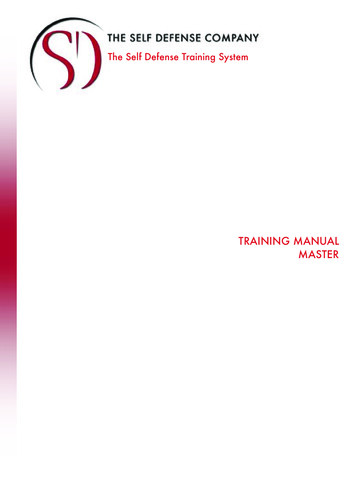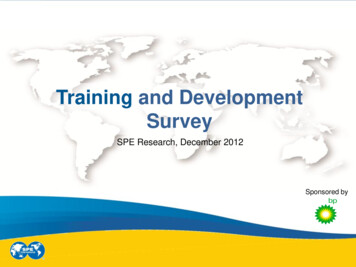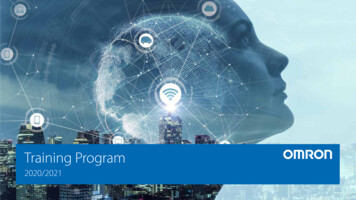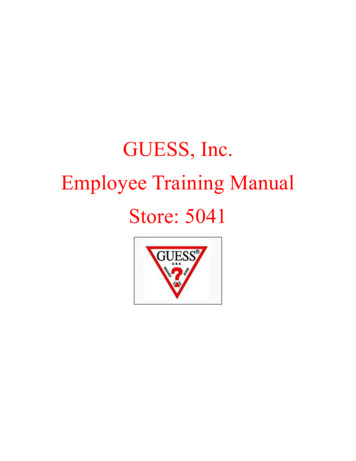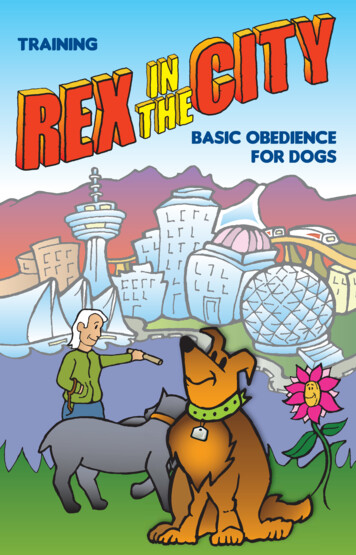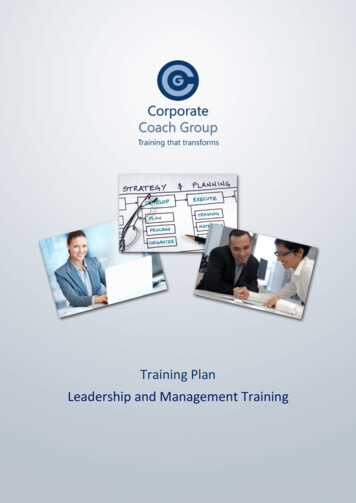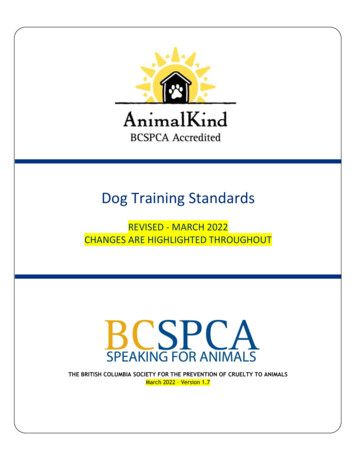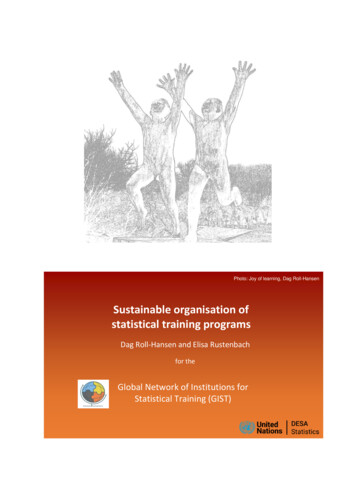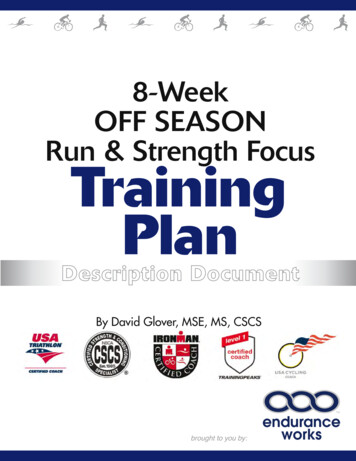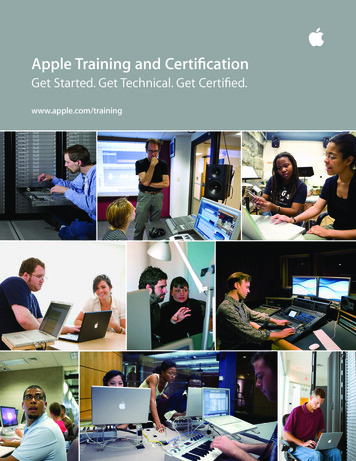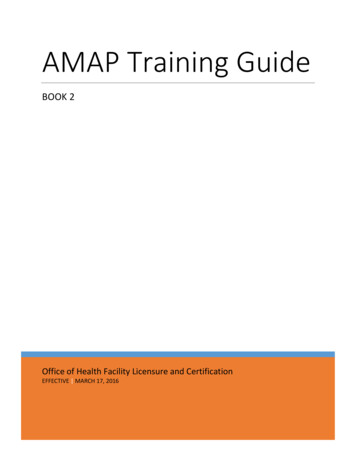
Transcription
AMAP Training GuideBOOK 2Office of Health Facility Licensure and CertificationEFFECTIVE MARCH 17, 2016
Trainee Handout 1.11.AMAP Scope and LimitationsAll medications administered by qualified personnel must be administered inaccordance with prescribed orders, facility policy, and all applicable Federal andState laws and regulations. Administration of medications may be delegated tonon-licensed staff in approved facilities. Medication Administration is assisting a person in the ingestion, applicationor inhalation of medications, including both perscription and non-perscriptiondrugs or using universal precautions for rectal or vaginal insertion ofmedication according to the printed directions by a physician or otherauthorized health care practitioner. Delegation is the handing over of a task to another person, usually asubordinate. It is the assignment of authority and responsibility to anotherperson to carry out specific activities or functions.2.Facilities/entities approved for inclusion in this program: ICF/MR (intermediate care facility for people with mental retardation) Assisted Living Residences (ALR) formerly called Personal Care orResidential Board and Care Homes Behavioral Health Group Homes Private residence in which health care services are provided under thesupervision of a registered nurse (RN)3.There are various routes by which an Approved Medication assistive Personnel(AMAP) is permitted by law to administer medications. The proper route foradministration must be specified in the physicians order. If the AMAP isadministering medications and the route is not specified on the MedicationAdministration Record (MAR) or order, she should immediately notify the RN.The RN is responsible for clarification of the physician order and correcttranscription onto the medication record. Oral: swallowed by mouth Sublingual: dissolved under the tongue Buccal: related to the cheek or mouth Topical: applied to the skin Eye (ophthalmic): drops or ointments inserted/applied to the eye Ear (otic): drops placed in the ear Nasal: placed in the nose/nostril Rectal: inserted into the rectum Vaginal: inserted into the vagina Inhalant: taken in through the mouth or nose by breathing in or inhaling Trans-dermal: absorbed through the skin through application of a patchTrainee Book1
4.5.The following may NOT be delegated to an AMAP: Injections Any parenteral (instilled into body tissue) medications Irrigations or debriding agents used in the treatment of skinconditions or minor abrasions Wound care An AMAP cannot transcribe a new physician order on the MAR.To be eligible for training and testing to become an AMAP and toadminister medications in a facility, you must: 6.have a high school diploma or GEDnot be listed on the State Nurse Aide Abuse Registryhave not been convicted of crimes against persons or drug related crimesas evidenced by a criminal background checkbe able to read, write and understand Englishbe certified in CPR and First Aide (and maintain certification)participate in the training program approved by the state and provided by aRN who has completed the department approved RN orientation coursepass the competency exam after the training programbe monitored and supervised by a registered nurseparticipate in a retraining program from an RN every two yearsThe AMAP approved RN is responsible for monitoring all AMAPs authorized toadminister medications. The RN must be available to the AMAP twenty-four (24)hours a day and respond to questions or concerns. The RN must ensure that afile is maintained on each AMAP verifying that they have met all eligibilityrequirements. The file must include a copy of their certificate for passing the test.It must also include all quarterly observations and two (2) year retrainingdocumentation. Medication error reports and any additional training should bemade part of the AMAP file. The RN is responsible for this documentation.Note:The registered nurse may withdraw authorization for an AMAP if the nursedetermines that you are not performing medication administration inaccordance with the training and written instructions or if the RN finds thatyou have falsified information to become an AMAP.Trainee Book2
Trainee Task 1.1 Worksheet1. “Medication administration” means:a. assisting a person in the ingestion, application, or inhalation ofmedications including prescription and non-prescription drugsb. assisting a person in the ingestion of special foodsc. assisting a person in the ingestion illegal drugsd. all of the above2. “Delegation” means:a. handing over a taskb. the assignment of authority and responsibility to another personc. representing a licensed nursed. a and be. all of the above3. List the required qualifications to become an Approved Medication AssistivePersonnel.4. Give an example of a situation where you would not administermedications:5. Who may withdraw AMAP privileges?6. Briefly describe the following routes of medication administration that arepermitted under the code/rule:A. oralB. ophthalmicC. oticD. inhalant/nebulizerE. nasalF. rectalTrainee Book3
G. vaginalH. topical/trans-dermalI. sublingualTrainee Book4
TASK 1.1 EvaluationsAMAP Scope and LimitationsINSTRUCTOR’S RATING SHEETRate Each Trainee IndividuallyTrainee Name: Date:Instructor Name:THE TRAINEECOMMENTS1.Able to verbalize clear understanding ofdefinitions2.Identified type of facilities where AMAPscan administer medications3.Verbalizes eligibility requirements forindividual to participate in AMAPprogramIdentifies routes thatadminister medications5.AMAPRATINGmayIdentifies limitations and verbalizes whatAMAP cannot doRATING DESIGNATION: A ACCEPTABLEU UNACCEPTABLETrainee Book5
Trainee Handout 1.2Medication Terms and AbbreviationsTo safely administer medications, you must be able to clearly identify and interpretseveral medical abbreviations. This list contains many of the more commonabbreviations used in ordering medications for administration and treatments, andcharting/documentation. ac : before mealsbid: twice a dayBP: blood pressurecap: capsuleĉ: withDNR: Do not resuscitate. This is a specific order not to revive a patient artificially ifthey succumb to illness. If a patient is given a DNR order, they are notresuscitated if they are near death and no code blue is called.ec: enteric coatedelix: elixirfl: fluidgtt: DropHTN: hypertension (high blood pressure)L: literMAR: medication administration recordml: millilitersnpo: Nothing by mouth. For example, if a patient was about to undergo a surgicalprocedure requiring general anesthesia, they may be required to avoid food orbeverage several hours prior to the procedure.O2: oxygenoz: ounceP: Pulse, Recorded as part of the physical examination. It is one of the “vitalsigns” and reflects the number of heart beats per minute.pc: after mealspo: by mouthPost : afterPre : beforeprn: as neededq: everyq am: every morningq.d.: every dayq2h: every 2 hoursq3h: every 3 hoursq4h: every 4 hoursqid: four times dailyqpm: each eveningR: respirationsŠ: withoutSL : sublingualSupp: suppositoryTrainee Book6
T: temperature. It is one of the “vital signs.”tab: tablettid: three times a dayTPR: temperature /pulse /respirationtsp: teaspoontbsp: tablespoonUA or u/a: urinalysisVS: vital signs (Temperature, pulse, respirations, blood pressure)Wt: weightThese are just a few of the many abbreviations used in the healthcare industry. The RNmust approve the use of any other abbreviation not identified on the list for use in thefacility. You must know how to use each abbreviation. Contact the RN anytime you donot clearly understand an abbreviation.Trainee Book7
Trainee Task 1.2 WorksheetIdentifying Medication Terms and AbbreviationsThe RN instructor can add to this evaluation as desired.Circle the correct answer.1. The abbreviation “tid” means:a. trendsb. 2 times a dayc. 3 times a dayd. time intake of drug2. The abbreviation “supp” means:a. sensoryb. suppositoryc. bring it downd. side of bed3. The abbreviation “TPR” means:a. temperature/pulse/respirationb. two perc. trooperd. blood pressure4. The abbreviation “bid” means:a. twice a dayb. immediatelyc. three times a dayd. standards5. The abbreviation “cap” means:a. capsuleb. control oxygenc. complains ofd. common obstruction6. The abbreviation “sl” means:a. sublingualb. signs and lesionsc. alertd. slightly legalTrainee Book8
7. The abbreviation that means fluids is:a. flb. flxc. H2Od. fsx8. The abbreviation “po” means:a. posterior objectb. by mouthc. purchase orderd. positive9. The abbreviation “qh” means:a. every hourb. every dayc. quarterd. none of the above10. The abbreviation “ac” means:a. after mealsb. air condition onlyc. before mealsd. after cause11. In healthcare, the abbreviation “MAR” means:a. means area rangeb. Medication Administration Recordc. mess upd. deface12. The abbreviation “BP” in healthcare means:a. barometric pressureb. basal pressurec. blood pressured. base pulse13. The abbreviation for capsule is:a. capb. cc. cpd. CPSTrainee Book9
14. The abbreviation that means “with” is:a. wb. sc. ćd. wi15. The abbreviation “prn” means:a. as neededb. practice rangec. per RNd. diagnosis matchTrainee Book10
TASK 1.2 EvaluationMedication terminology and abbreviationsINSTRUCTOR’S RATING SHEETRate Each Trainee IndividuallyTrainee Name: Date:Instructor Name:COMMENTSTHE TRAINEE1.Able to accurately identify s3.Utilized abbreviations correctlyofRATINGcommon5.RATING DESIGNATION:A ACCEPTABLEU UNACCEPTABLETrainee Book11
1.3 Trainee HandoutMedicationsPrescription drugs and non-prescription/over the counter (OTC) drugsAll Prescription drugs are designated as:1. Controlled or Schedule I - V DrugsThere are five (5) categories or schedules of drugs based on their potential tocause psychological and/or physical dependency as well as their potential forabuse. They range from Schedule I for substances with a high abuse potentialand no current approval for medical use (e.g. heroin, marijuana, LSD, etc.) toSchedule V for substances containing limited amounts of certain narcotic drugs(cough medicines and diarrhea medicines).Narcotic: central nervous system depressant agent containingopiods or drug that has morphine-like actions.a. Designated as a controlled substanceb. Have a high potential for abusec. Require special storage, usage reporting procedures anddestructiond. Cannot be dispensed without a doctor's prescriptione. Can only be administered by the AMAP when the medicationorder is written with specific parameters that precludeindependent judgementAdministration of schedule drugs must be accurately documented and allmedications must be accounted for at all times. Review facility policy for proof ofuse documentation, medication security for control drugs, accessibility, andrequirements for counting control drugs and destruction policy.2. Non-controlled Drugs: All other prescription drugs not on the Board ofPharmacy controlled substance list.Non-prescription/over the counter drugs (OTC):a. Can be purchased by the consumer without a prescriptionb. Physician order needed for use in the facilityc. Can be administered by the AMAPd. Can produce unwanted effectse. May interact with prescription drugs or foodsTrainee Book12
f. Must have facility specific policies in place for administrationEffects of Medication:The human body does not always function perfectly. Sometimes a person willtake medication to help the body do its job better. There are four (4) outcomesthat may occur when a drug is taken:1. Desired effect2. Unwanted effect (sometimes called side effects or adverse drugreactions)3. Drug interactions4. No apparent effect1. Desired Effects:Medications are given or prescribed for many reasons. Some examplesinclude: Promote health: example - nutritional supplementEliminate illness: example - antibioticsControl a disease: example - oral hypoglycemicReduce symptoms: related to illness: example-cough suppressant, aspirinAlter behavior: example - anti-anxiety, anti-depressant, anti-psychoticWhen the prescribed drug is working correctly, we say the medication isproducing the desired effect. The desired effect is the beneficial effect we wantthe drug to accomplish.2. Unwanted Effects:When a drug is taken, there is always the possibility that the resident may nothave the response to the drug that was expected to occur. Some of theoutcomes can be life threatening such as a serious reaction to penicillin.There is always the possibility that unwanted effects will also occur. Sometimesthe unwanted effects are predictable. Often they are called side effects oradverse effects.An example of an unwanted effect is drowsiness produced by sedating coldmedications. Drowsiness may not occur in every person for whom the drug wasprescribed, but happens frequently. Constipation is an unwanted effect that mayoccur when taking iron preparations.Unwanted effects may be unexpected and unpredictable. Many elderly peoplebecome confused when starting on a new drug. Some people are very allergicto a drug such as penicillin and have a reaction that could be fatal.Trainee Book13
Looking for Unwanted (side) Effects of Drugs:Unwanted effects show up in either physical or behavioral change. Any changeoccurring in the first few days of a new drug is important because it may havebeen caused by the drug. You can encourage the resident to report anychanges and be observant for complaints. Any behavioral or physical changeswhich may be drug related should be reported to the RN.Examples of unwanted effects:1. Rashes2. Diarrhea3. Vomiting4. Fainting5. Lightheadedness6. Blurred vision7. Confusion8. Irritability9. Agitation10. Lethargy3. Drug Interactions:When a person is taking two or more drugs at one time, the drugs may interactwith each other. The greater number of drugs taken, the greater chance forinteraction.Drug interactions may: Increase the effects of one of the drugs - called potentiation Decrease the effects of one or more of the drugs - calledantagonism Produce a new and different unwanted (side) effect May react with certain foodsTHE GREATER THE NUMBER OF DRUGS TAKEN AT ONE TIME,THE GREATER THE POSSIBILITY OF A DRUG INTERACTION.4. No Apparent Desired Effect:Different drugs require different amounts of time before their effects areobservable.For this reason, the nurse will tell you how long it may takebefore the expected action can be seen. If the time expected has gone by,Trainee Book14
and no apparent desired effect from taking the medication can be seen, theAMAP should notify the RN. For example, if acetaminophen was orderedand given and the fever remains unchanged, there is no apparent desiredeffect.Trainee Book15
1.3 Trainee HandoutUSING DRUG INFORMATIONUsing the Pharmacy drug information sheet review the information on Ibuprofen. Youcan use any other recognized drug information resource.1. Read the section that identifies purpose and intended effects of the drug.2. Read the section on side effects. List the side effects on a piece of paper.Think about any resident you know who may be taking Ibuprofen (Nuprin,Advil, Motrin IB) and decide if you can identify any of her/his behaviors orphysical complaints that may be related to Ibuprofen side effects.Recommended Reference:1. Nursing Drug Reference Book2. Pharmacy patient information insertsUse drug reference materials and look up medications you have seen used frequentlyfor your residents. Review listed drug purpose and side effects. Additional druginformation is available from the pharmacist and pharmaceutical manufacturers. Theinserts obtained from the pharmacy are a good reference.When a new medication is ordered for a resident/client that has not been includedin the training and/or curriculum, the AMAP must check with the RN forinformation on this drug and check facility resources. Before administering amedication, you should know the name of the medication, its purpose, and common sideeffects for the new medication.Medication information resources:- facility books- drug information inserts- pharmacy print outs- on-line web sites (where available)This important number should be posted in the facility.Poison Control Hotline 1- 800-222-1222Provides Information on Poisons and Drug IdentificationReview the attached chart which is for reference only. You must understand thepurpose and effects of medications used in your work setting.Trainee Book16
Not all side effects are included in this list.Drug TypeAnti-infectiveRespiratory tractdrugsName of DrugPurposeSide EffectsOmnipen(Ampicillin)InfectionGastritis, fatigue,diarrheaAugmentin(Amoxicillin)Keflex (Cephalexin)Bacterial InfectionRash, diarrhea,allergic reactionGastritis, terol (Ventolin,Proventil)Metaproterenol(Alupent, )BronchospasmMaxair nes:Dimetane, ChlorTrimton, Dimetapp,Dramamine,Benadryl, Claritin,ZyrtecAllergic reactions,Rhinitis, motionsicknessInfectionDiarrhea, nausea,vomitingTremor, sed BP,dizziness,headache, irritatedthroat, , dry , drymouth, anorexia,bad taste,abdominal pain,rash, edemaDry mouth,tremors, vomiting,diarrhea,nervousness,insomnia,headache, increasedheart rateDrowsiness,confusion, fatigue,dry mouth,nervousnessTrainee Book17
Drug TypeCentral NervousSystemCentral NervousSystemName of DrugPurposeSide ess, sedation,rigidity, akathesia, bloodpressure iasomnolence,akathesia, chizophreniaextra pyramidalreactions, agitation,tardive dyskinesia(TD), constipation,hypotensionSeroquelManagement on,leukopeniaZyprexaSchizophrenia andshort termtreatment of acutemaniaparkinsonism,dizziness, TD, bloodpressure changes, drymouth, increasedappetite, leucopeniaAnxiety, panicdisordersDrowsiness,headache, dizzinessAnxiolytics:XanaxTranxene, BuSpar,Valium, AtivanNarcotic/opiodanalgesics:AnxietyDarvocet N,Darvon N,Endocet, Fiorcet,Fiorinal, Lortab,Percodan, Vicodin,Tylenol withCodeinePainSedation, dizziness,physicaldependenceTrainee Book18
Drug TypeCentral NervousSystemAnti-convulsant drugs donot cure seizures theyonly control them. Somedrugs work by makingover-active brain cellsless excitable and otherwork by decreasing thebrain cells' ability totransmitabnormalimpulses to each othercausing a seizure.Name of DrugPurposeSide EffectsNon-narcoticanalgesic:Tylenol, AspirinMotrin, AdvilPain, arthritis, feverHeadache,dizziness, thritisDizziness, headachePrevent and sionMysoline, PrimidoneSeizuresDrowsiness, fatigue,vertigoTopamaxAdjunctive therapyfor seizuresConfusion,agitation, drymouth, leukopeniaDepakene,DepakoteSeizures, treatmentof mania,prevention ofmigrainesSedation,depression,increased appetite,hyperactivitySeizuresFatigue, headache,dizzinessSeizures, neuralgiaFatigue, dizzinessTrileptalNeurontin andTegretolTrainee Book19
Drug TypeCentral NervousSystemAntidepressants are usedprimarily to treatsymptoms of depressionsuch as appetite loss,difficulty sleeping, lowenergy, and low ordepressed mood. Thesemedications are alsoused to treat anxiety andobsessive-compulsivesymptoms.Name of DrugAntidepressants:ElavilPurposeSide EffectsDepressionTremor, anxiety,headacheDepressionHeadache, , fatigue,tremor, tachycardiaSinequanDepressionDizziness,weakness, drymouthLexaproDepressionDizziness, tremor,hypertensionProzacDepression,bulimia, panicdisorderFatigue, ess,hypotensionPaxilDepression, OCD,panic disorder,PTSDDizziness, tremor,dry mouth, anxietyZoloftDepression, OCD,panic disorder,PTSDHeadache, tremor,dizziness, anxiety,dry mouthEffexorDepression, anxietyHeadache, tremor,dizziness, anxiety,dry mouthWellbutrin,Wellbutrin SRTrainee Book20
Drug TypeCardiovascularsystem drugs:Agents that affect therate or intensity ofcardiaccontraction,blood vessel diameter orblood volumeName of DrugPurposeSide EffectsLanoxinHeart failure, atrialfibFatigue, muscleweakness,Headache, dizzinessCalanAngina, atrial fibHeadache, dizzinessHypotensionCardizemAngina, atrial fib,hypertensionHeadache, inessHypotensionNitro-Dur, NitroBid, NitrogardAnginaweakness,Headache, dizzinessIsordilAnginaweakness,Headache, dizzinessInderal, nHypotension,Headache, dizzinessPrinivil, orvascAngina,hypertensionHeadache, zziness, fatigueCatapres, ClonidineHypertensiondizziness, fatigue,hypotensionCapotenHypertensiondizziness, fatigue,hypotensionTrainee Book21
Drug TypeDiuretics:Name of DrugPurposeSide EffectsDiureticsare used to treat thebuildup of excess fluid inthe body that occurswithsomemedicalconditionssuchascongestive heart failure,liver disease, and kidneydisease. Some diureticsare also prescribed totreathighbloodpressure. Most of thesedrugs act on the kidneysto increase urine output.This reduces the amountoffluidinthebloodstream, which inturnlowersbloodpressure.LasixEdema, tensionMaxide, Diazide,BumexEdema caused byheart failureDrowsiness,weakness, ess,gastritisHormonal drugsAntidiabetics:Glipizide, GlucotrolLower glucose levelin Type II Diabetesand replace insulintherapyDizziness,headache, nausea,constipationGlyburide, DiaBeta,MicronaseNausea, heartburn,leukopeniaAvandiaImprove glycemiccontrolFatigue, headache,diarrheaStarlix, AmarylLower glucose levelin Type II ess,headache,tachycardia,diarrhea, rmones:Synthroid, LevoxineEstrogen:Estrace, PremarinOsteoporosis,menopausalsymptomsTrainee Book22
Drug TypeName of DrugGastrointestinaltract drugsAnti-ulcer: Zantac,Tagamet, Nexium,Pepcid, Prilosec,Prevacid, Protonix,CarafatePurposeSide EffectsGastric ulcer,reflux, heartburnDizziness, headacheAntacidHeadache,irritabilityLaxatives: Fiberall,Surfak, Enulose,Mg Citrate,Citrucel, Metamucil,Senokot, Milk ofMagConstipationCramping, diarrheaTobrexOcular infectionsBurning, itching,swellingPilocarpine,Alphagen, Xalatan,Timoptic, TravatanGlaucomaDizziness, eyeirritation headacheVisineEye irritationHeadache, blurredvisionOtic DrugsChloromycetin OticEar infectionItching, burningNasal DrugsCerumenexBeconase,Rhinocort, FlonaseImpacted cerumenRhinitis, inNasal CongestionHeadache, dizzinessAntacids: Tums,Maalox, Rolaids,MylantaOpthalmic DrugsThis chart is for reference use only.Trainee Book23
Trainee Task 1.3 WorksheetIdentifying Types of MedicationsCircle letter of the correct answer1.Amoxicillin is an example of which type medication?a. Hormoneb. Anti-infectivec. Cardiovascular drug2.Estrace is an example of which type of medication?a. Mental health drugb. Antibioticc. Hormone3.Xanax is an example of which type of medication?a. Respiratory drugb. Drug that affects the central nervous systemc. Gastrointestinal tract drug4.Which drug is an example of a cardiovascular system drug?a. Methotrexateb. Lanoxinc. Dilantin5.Which drug is an example of a respiratory tract drug?a. Ventolin Inhalerb. Tagametc. Amoxicillin6.Norvasc is an example of:a. Cancer drugb. Gastrointestinal tract drugc. Antihypertensive drugTrainee Book24
7.Which is NOT an example of a topical medication?a. Creamb. Capsulec. Ointment8.The various classes of medication fall into the categories of prescription drugsand over-the-counter drugs. Which of the following statements aboutprescription drugs is not true?a. The RN must delegate their administration by the AMAP.b. You must be an authorized AMAP in order to administer.c. They may be administered without a doctor's order.9.Which of the following statements about over-the-counter drugs is not true?a. They must only be administered with a Physician orderb. They may be administered without a Physician orderc. They can produce unwanted effects10.Which of the following statements accurately describe a drug on the controlledsubstance list?a. Can be administered without a doctor's prescription or patient's signatureb. Will not produce unwanted effectsc. May require special storage, usage reporting procedures and destruction11.Which of the following drugs is an “over-the-counter” drug:a.b.c.d.12.GeodonPaxilTylenolLasixWhich of the following is an appropriate reference for drug information:a.b.c.d.the encyclopediaWebster DictionaryNursing Drug HandbookRedbookTrainee Book25
13. A narcotic is a:a.b.c.d.central nervous system stimulantcentral nervous system depressantbronchodilatorantidepressant14. Which of the following statements is not true:a. all drugs have potential side effects or unwanted effectsb. two or more drugs may interact with each otherc. different drugs require different amounts of time before their effects areobservabled. the greater the number of drugs taken, the less possibility of a druginteraction15. Which of the following drugs is not an inhalant medication?a. Visineb. Flonasec. Afrind. RhinocortTrainee Book26
1.3 Recognizing Purpose and Effects of MedicationsCase and Questions:Jerome Bender is a resident at the facility where you work as an AMAP. He is aresponsible person capable of making decisions about his medication. He received aprescription for Dilantin to control his recent onset of seizures. He is reluctant to takethe medication because he is not sure what the medication is for and is worried aboutunwanted effects.Mr. Bender has some specific questions about unwanted effects of Dilantin. Tell himwhich licensed health care professional(s) can provide him with specific informationabout unwanted effects of Dilantin. Describe the process of notifying the RN of hisconcern.If Mr. Bender’s seizures are not affected by the Dilantin after five days, is this anunwanted effect or no apparent desired effect?Mr. Bender takes the Dilantin for several days with no unwanted effects; however, hereports extreme drowsiness after taking a sedating cold medication within an hour ofhis regular dose of Dilantin. What type of unwanted effect might be occurring?Trainee Book27
1.4 Trainee HandoutTHE SIX RIGHTS OF MEDICATION ADMINISTRATIONEACH TIME YOU ADMINISTER OR ASSIST WITH THE ADMINISTRATION OF AMEDICATION YOU SHOULD BE SURE YOU HAVE FOLLOWED THE SIX RIGHTS: RIGHT RESIDENT RIGHT DRUG RIGHT DOSAGE RIGHT TIME RIGHT ROUTE RIGHT RECORDNurses have long referred to these factors as the "six rights" of medicationadministration. Each time a drug is given, you should use a system to follow the sixrights. Check all six rights every time you administer a drug. You should never tryto administer medications from “memory”.Right Resident 1. Know the residents2. Check with other staff if you are not familiar with resident3. Check resident identification source per facility policy i.e.: picture orarmband.4. Check for drug and latex allergies on each resident.Right Drug To make sure you give the right drug, use the following process:1. Compare information on the Medication Administration Recordand the pharmacy label.2. Make sure they agree.3. If they do not agree, recheck to find out what is different.Contact the RN immediately for further instructions.Trainee Book28
Right Dosage –Compare the MAR with the pharmacy label to make sure they agree.Right Time –The pharmacy label and MAR will tell you how often the drug should be taken. Yourfacility should have a time schedule for administering drugs. The RN must fill in thetime schedule on the MAR. It is best to administer medications no earlier than one (1)hour before the scheduled time and no later than one (1) hour after the scheduledtime. If you are unable to administer the medication within an hour of the assignedtime, contact the RN for further instructions.Your Facility's Time Schedule for Administering Drugs:Daily:Twice a day (bid):Three times a day (tid):Four times a day (qid):Every six hours (q6h):Every eight hours (q8h):Every morning (q AM):Nightly:Some drugs must be given at a specific time: for example, before meals,one hour after meals, and at bedtime. These drugs should be given asprescribed. The RN must indicate any special instructions for administration onthe MAR including the time the medications are to be administered.PRN Drugs - These drugs are ordered to be given “as needed.” Many pain relievers,laxatives and "sleeping" pills fall in this category. When the resident has difficultycommunicating, it may be hard to determine the need for these drugs. The PRN ordermust be written with specific guidelines that include dose, frequency andpurpose. For example: Give Motrin 200 mg, two tablets daily by mouth for pain, whenneeded. The RN is responsible for ensuring that each prn medication has specificguidelines.Trainee Book29
Right Route –Each medication is prescribed to be taken in a certain form and by a certain route. The oralroute (by mouth) is the most common method of medication administration, but there are anumber of other routes.In some cases
Trainee Book 2 4. The following may NOT be delegated to an AMAP: Injections Any parenteral (instilled into body tissue) medications Irrigations or debriding agents used in the treatment of skin conditions or minor abrasions Wound care An AMAP cannot transcribe a new physician order on the MAR. 5. To be e

